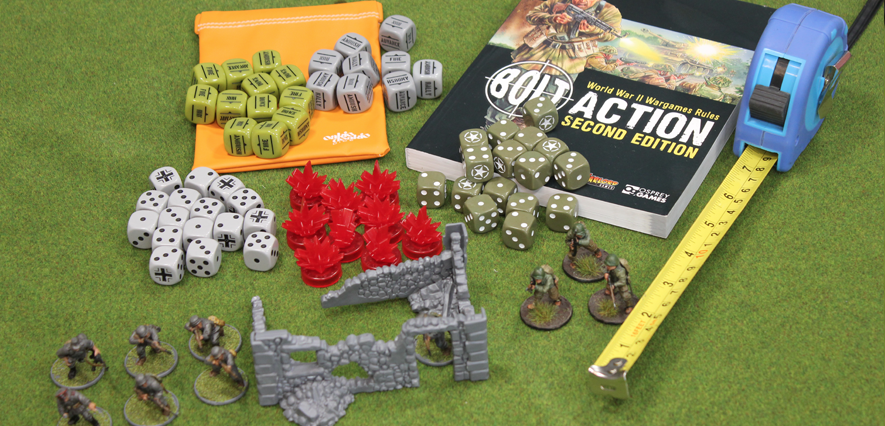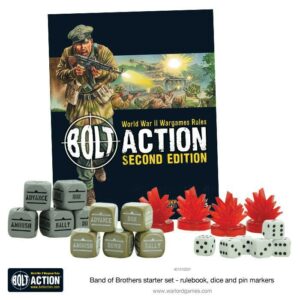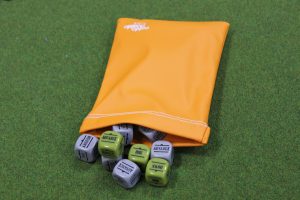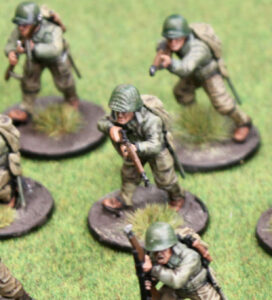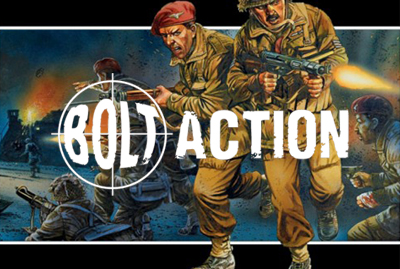Bolt Action is, at its heart, a simple and fun World War 2 miniatures war game that’s really easy to pick up and play.
Many of the basics will be familiar to players coming from Warhammer 40,000 or other tabletop games, but are still simple to understand even if you’re a complete newcomer to the tabletop game genre.
What you’ll need to play Bolt Action:
To play a game of Bolt Action you’ll need: some models, some rules, a tape measure, a table to play on with some scenery, some 6-sided dice, and the Bolt Action secret ingredients – the order dice, and something to use as “pin markers”. You’ll also need a (non-see-through) bag or cup that you can use to draw the order dice from.
It sounds like a lot but if you don’t have any scenery or pin markers to hand, then there’s a long and noble tradition in wargaming to use some household items. Can or bottle can play the part of a grain silo, a shoebox as a barn, and so on. The author has played at least one game where takeaway tubs played the role of landing craft for a D-Day scenario. As a hobby, it’s all about imagination and a game around some scenic features will be more fun than one on a featureless table.
You’ll get everything you need (apart from the tape measure, the bag, and the table) in the current “Band of Brothers” starter set, and this is great value, giving you some American airborne troops, some German army Grenadiers and an SdKfz 251/10 / Anti-tank Hanomag / Half-track with a big gun (delete as applicable for your level of German vehicle nerdiness).
From there you can expand your Bolt Action army, choosing from a huge range of miniatures from a variety of manufacturers. While naturally there’s a focus on the five major factions of Germany, Japan, the USSR, the USA, and the British Empire, you can find models for all sorts of nations and rules to match.
Basic Principles of Bolt Action
The core of Bolt Action is that it’s NOT a game where one player takes a full turn, moving and fighting with all their models, then the other player does. That kind of system, known as IGOUGO (I Go, You Go) has strengths in simplicity and the ability to make coordinated tactics, but can have downsides. If it’s not your turn, then often you won’t have much to do except roll occasional saving throws and pick up your casualties. Also, IGOUGO can become a game of whoever goes first, wins.
Bolt Action uses a system of randomised unit activations. Each turn, every unit on the table will get a chance to activate, but the order in which it happens is randomised. To do this, each player has a set of tokens (usually special “Order Dice”) which are placed into a bag together and then drawn out blind. When one of player 1’s tokens is drawn, they can activate one of their units, which they do by giving it an order. It can advance – making a tactical move and making an attack. It can fire – standing still to make an attack. It can run – move at double speed but giving up it’s attack. It can go down – hitting the deck in order to try and reduce the chance it will be hit. It can rally – attempt to improve its morale and fighting effectiveness. Or, it can ambush – stay still and wait for a target of opportunity to present itself. These orders are represented on the bolt action order dice and these are what are nearly always used to play the game.
Each unit makes its activation, then another dice is drawn from the bag, until all the dice are removed, then a new turn begins. It’s an elegant system and means both players are fully engaged most of the time. Each dice draw is an event – sometimes you’ll desperately want to see your dice come out of the bag so you can activate. Sometimes, you’ll be hoping your opponent has the early draws so you can pounce with a counter stroke after they’ve exposed their plan. It gives a real feel of the chaos and improvisation of battle.
The other principle that really characterises Bolt Action as a game is the high level of abstraction and standardisation of weapons and troops. On the troops side, I’ve heard Warhammer 40,000 players remark that “the game is basically 40k, but everyone’s an Imperial Guardsman with a lasgun”.
That’s an oversimplification but it holds true. As this is a World War 2 tabletop game all the infantry are humans and they only really fall into three groups.- Inexperienced, Regular, and Veteran. All this affects is a couple of things – Inexperienced troops are less effective at shooting and more likely to fail to follow orders. Conversely, veteran troops are tougher to kill, and more likely to follow orders.
The good news is you don’t have to memorise a lot of stats for each model. In Bolt Action, your troops hit the target when they roll a 3 or better, and wound the target when they roll a 4 or better. Weapons are all drawn into broad categories – every rifle is basically the same. The vast array of weaponry used between 1939 and 1945 is neatly sorted into 27 archetypes. There’s a layer of modifiers to rolls to lay over the top of it, but the result is that there’s a lot less memorisation or checking reference books needed.
Pinning
The final basic thing to remember is “pinning”. This is how Bolt Action simulates that being under fire is stressful and distracting, and that the men under your command aren’t suicidal fanatics (well, usually not). As a unit comes under fire, it will be assigned Pin markers, to represent the fear, distraction, and reduced situational awareness inherent in dodging incoming fire. Pin markers make it harder to shoot successfully and make it more likely a unit will refuse to do what’s asked of it.
Bolt Action Armies
With all this standardisation you might think that every army would play the same, but Bolt Action deals with this via each army having a couple of special rules. We can go into more detail about this in other articles, but for instance let’s look at the contents of the Band of Brothers starter set – Americans versus Germans.
The Americans’ first special rule is that they can move and fire their most common weapons without penalty (representing their semi-automatic M1 Garand rifles and their tactical doctrine – how the US army trained its men to fight.). Another is that they can include more independent machine gun teams in their armies than other nations (The US army loved a bit of extra dakka). Finally, to represent their air power, each Air Force spotter they take can call down two air strikes per game instead of one.
For Germany, the first is that their light and medium machine guns get an extra shot each time they fire, representing the extreme fire rate of the MG42. Also, to represent their training, they can ignore the bad effects of having their NCOs killed.
As you can see, these special rules that Bolt Action apply to each army creates a unique gaming experience for players, and with it, opens up a myriad of tactical options, both in how you play your army, but also in how you respond to the unique threats that each army you face bring to battle.
Learn More
So how does this all come together on the tabletop?
Check out the next article in our How To Play Bolt Action series where we walkthrough an example turn, detailing the action as it plays out. We’ll be using the contents of the Band of Brothers starter set to show some of the main mechanics in action. If you’re wondering about what comes in this set, check out the Bolt Action Starter Set here.
That’s it for the basics. See you in the trenches!
